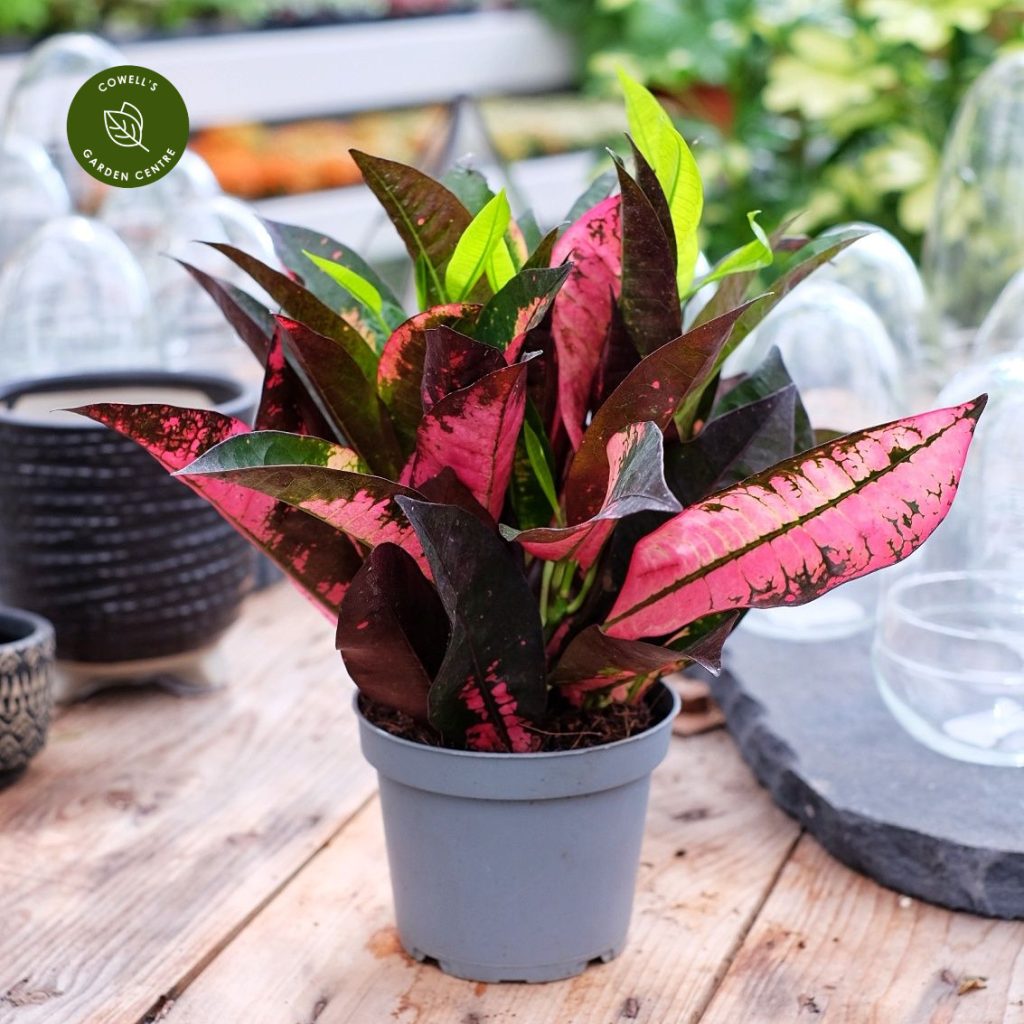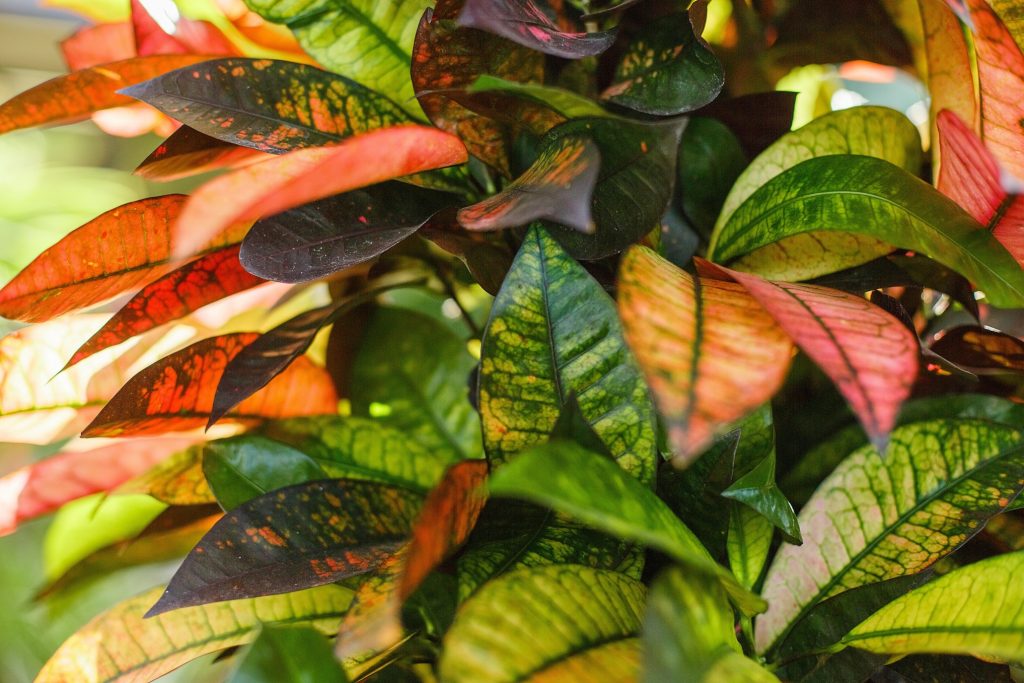Colorful plants always seem to top the list among plants that are grown in the home, like houseplants. Plants in the croton family are one of the most gorgeous plants that are grown as houseplants.
Growing a plant that comes in varieties allows you to have plants of the same family in your home, but with different shapes and colors.
Ice ton croton (Codiaeum variegatum) is native to Malaysia and is one of the most stunning varieties of the croton plant. The plant stands out with its lovely and bright foliage which starts with green and yellow and over time develops to shades of pink, red/maroon.
The foliage of the iceton croton is oval and pointed, together with its leaves, which can grow to about 6 inches long.
Ice ton croton is often regarded as a large grower as it can grow to about 6 to 10 feet tall at maturity etc. Iceton croton in the home surely contributed its lovely and delectable colors to the beauty of the home. Iceton croton will grow either as a houseplant or in the garden.
A stunning variety of croton is the iceton. Although rare, it can be found and is grown by many. Here is some information on ice ton croton, and how to care for and propagate it.
How To Propagate Iceton Croton Plant
An important part of having plants in your home or garden is that you can propagate them, to either sell or keep them around for a long time.
For many other plants, propagating can be a challenging task to perform, however with croton, propagating is one of the easiest things to do.
| Plant name | Croton |
| Botanical name | Codiaeum Variegatum |
| Plant type | Shrub |
| Size | 6 to 10 ft |
| Soil type | Well-draining |
| Soil ph | Acidic |
| Native | Malaysia |
| Light | Full sun/ partial shade |
| Toxicity | Toxic to Humans and Animals |
Needs For Propagation
- A healthy croton plant
- Sterilized shears
- Rooting hormone
- New pot
- Mix of peat moss and perlite.

Steps To Propagate The Iceton Croton
Although croton can be propagated in several ways, such as air layering, stem cutting, and petiole rooting; the easiest way to propagate croton is via stem cutting, and we will show you below.
Step 1
Get a healthy iceton croton mother plant and with the use of a sterilized shear, just below a leaf nodule, make a cutting of about 4 to 6 inches long. Remove the leaves at the bottom of the cutting; however, the cutting still has about 3 to 4 leaves on it.
Step 2
Dip the cutting end into a rooting hormone to ensure that your plant roots on time and properly. Place the cutting on a paper and allow it to dry.
Step 3
Plant the cutting in a mix of perlite and peat moss and water it. Cover the plant with a plastic bag (this is to give it a greenhouse effect). Keep the plant moist by watering it often; keep it at a temperature of 70 degrees F. Your plant should develop its root in 4 weeks.
Ice Ton Croton Plant Care And Propagation Guide
Bringing the gorgeous iceton croton into your home is one thing, providing for its basic requirements and care guide is another. Below are some of the care guides we thought to help you with.
1. Watering
Watering is important to all croton, and for iceton croton. Iceton enjoys being evenly moist, especially during the summer. However, although croton loves to be kept moist, it also wants to be watered only when its soil is dry.
We recommend that you give your iceton croton one inch of water weekly, during the summer, and water bi-weekly in the winter. You can also use a water calculator to tailor watering recommendations to your specific location.
Ensure to mist your iceton during its growth period.
2. Light
Similar to other varieties of croton, iceton requires an adequate supply of bright and direct sunlight, although it can survive in indirect light, it is recommended to place it in full sun. Keep the plant one foot away from the window and nothing more than that, this will ensure it receives enough sunlight.
Keeping it in full sun helps to keep its foliage bright, colorful, and vibrant, however not providing it with this amount of light can make the leaves turn green.
3. Soil
Iceton croton does best in well-draining soil. The perfect soil for your iceton is the humus-rich, acidic soil it should also include organic matter i.e., vermiculite, perlite, coco coir, etc. if you’ll be purchasing a store-bought potting soil, ensure to add some perlite to make it rich enough for your plant.
4. Humidity
Lucky for you, iceton croton doesn’t require additional humidity; it will do just fine in the home. Furthermore, iceton, like other plants, collects water through its root system rather than its leaves, therefore you should water the soil as much as possible to ensure humidity for your iceton.
5. Temperature
The iceton croton is best kept in a room above 60 degrees Fahrenheit, it is best to not expose the plant to cold drafts. She
6. Fertilizer
Iceton croton may not require as much fertilizer as you may think. This is because; the plant gets its nutrient from the soil/sunlight and not from fertilizer. However, during the growing season, you can supply the plant with fertilizer to enhance its growth, this should be done once.
You must read the instructions on the fertilizer pack, to know the feeding quantity.
We however recommend that you dilute the quantity written on the pack to half its strength before giving it to the plant. Do not give your plants fertilizer during the winter months.
7. Pruning
Iceton croton is prone to becoming leggy, however, croton can be trimmed and should be trimmed. Prune your plant when you notice it is becoming leggy and at the beginning of the growing season. Also, trim off unhealthy leaves and branches and keep them to your shape or taste.
Growing Tips Iceton Plant
Growing croton outdoor or indoors requires attention. Although they are easy to care for, however, the growing tips listed below can make it even easier.
- Iceton croton leaves can roll or twist, especially when the leaves become large, however, this can be a result of too much fertilizer, or inadequate sunlight. To correct this, reduce the fertilizer and place the plant where it can get adequate sunlight.
- Leaf dropping can occur as a result of cool temperatures or cool drafts, in cases like this, take the plant indoors and increase the temperature. Insects and pests can also cause the leaves of the croton plant to drop, ensure to clean your plant’s leaves with insecticidal soap to get the bugs off.
- Crown gall is a bacterial infection that is common to croton. On the plant’s stem and leaf veins, it appears as a thick, swollen growth. If you see this change in your plant, it’s best to remove it from the soil and discard it. Because this disease can transfer from one plant to another, clean and disinfect the container and other gardening utensils.
- Anthracnose, often known as leaf spot or leaf blight, is a fungal infection. Anthracnose shows on the leaves as brown colored dots. If this happens to your plant, it’s best to clip off the affected foliage and keep it from spreading to other plants. If a big portion of your plant is infested, you should use an insecticide to treat it.
- Iceton is susceptible to some insects such as mealybugs, spider mites, thrips, and scales. However, all of these can be removed with the use of insecticidal soap or essential oil. You can also make use of less harsh pesticides.
- Because ice ton croton is sensitive to cold winters, you should add about two inches of mulch around the base of the plant to insulate the roots if you reside in a cold climate. Gardeners’ blankets can also be used to keep the cold at bay.
- It is advised that you re-pot your young iceton croton yearly, especially during the spring and summer. Afterward, only repot your plant when the roots are growing out of the drainage holes. Ensure to purchase a pot that is bigger than their present pot.
FAQs
Is Iceton Croton Toxic?
How Long Do Iceton Croton Live?
Where Should I Put My Croton Plant?
Final Thoughts
Growing iceton croton isn’t as hard as it sounds, however you will be required to pay attention to details. Iceton croton can be grown via seed; however, it is not encouraged as it will not resemble the mother plant, as much as growing via cutting would.
Ensure to keep your plant in full light as placing them in shade can make their leaf dull. Overwatering, low or high temperature and fertilizer are some little details to pay attention to.
More houseplant care guides:
- Superstar Croton Plant Care And Propagation Guide
- Scindapsus Varieties: 6 Types Of Scindapsus Plants To Grow Today
- Philodendron Brandi: How to Care For Them
- Sunny Star Croton Plant Care And Propagation Guide
- Gold Dust Croton Plant Care And Propagation Guide
- Croton Zanzibar Propagation And Care Guide
- Superstar Croton Plant Care And Propagation Guide
- Banana Croton Plant Care And Propagation Guide
- Croton Magnificent Care And Propagation Guide
- Friendship Plant Care: How to Grow Pilea Ivolucrata
- Oakleaf Croton Plant Care And Propagation Guide
- Epiphyllum Cactus: How to Grow And Care For This Cacti


